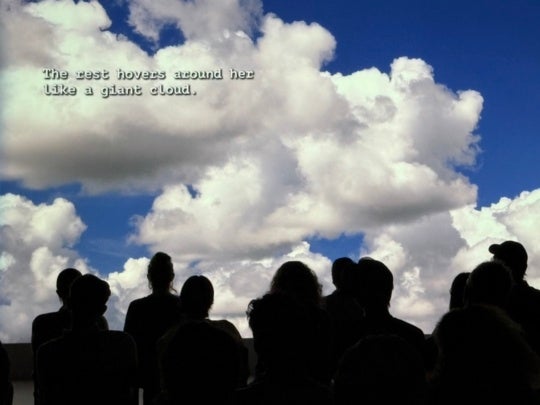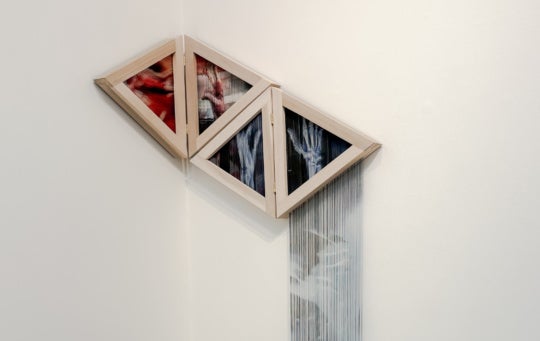
The waters are being tested in Asheville at 22 London, a new art venue named for its address—in an area that is notably off the beaten path of the city’s art scene. On two nights in May, crowds gathered in this spacious white cube of a former warehouse to experience “Love, Devotion, and Surrender,” an ambitious show of video works by nine international artists. The exhibition, organized by Asheville polymaths Randy Shull and David Raymond, centers around the themes of eroticism and—fitting the medium in question—voyeurism.
The featured works engage these themes in a variety of modes and levels of provocation (although it must be said, never to the point of full-frontal raunch). They range from the nakedly emotional to the romantic to the humorous to, of course, the uncomfortably prurient.

Bill Viola’s 2005 Becoming Light falls squarely in the romantic category: a male and a female swimmer embrace in slow motion, suspended like heavenly bodies in a universe of blue water, eventually coalescing into a single orb and disappearing together. In the context of this show, Petra Cortright’s tiny video charmer, Sparkling 2 (2010)—displayed on a cellphone screen—takes on a super-intimate, possibly even onanistic aura: over the course of about a minute, the artist prances on the miniature screen, waving a tree branch that sends off digitally effected glitter. Mexican-Canadian artist Rafael Lozano-Hemmer likewise shows off some digital prowess with his interactive 2008 work Making Out. Displayed on a screen with a built-in tracking system are hundreds of squares, each showing a couple gazing at one another; when the viewer stands or moves in front of the display the couples shift and kiss.

There is no shortage of humor in “Love, Devotion, and Surrender,” but it isn’t always delivered in an easy form. With his usual gonzo wit, Tony Oursler serves up Invisible Green Link, a 2007 wall piece from his series Ooze. Here, a communicative, bloodshot eye stares out with a look of—is it judgment? desperation?—from a 2-D green blob, watching us watching it watching us watching it. Jen DeNike’s The Cat (2015) is the mesmerizing, if perplexing, adventure of a man in a red-and-white-striped cat costume cavorting balletically by a series of turquoise swimming pools.

In Feeding (2014) we watch with growing discomfort as artist Shana Hoehn shoves mounds of saucy spaghetti into her mouth, using utensils from which doll parts dangle, somehow obscenely. Hoehn’s video screen, embedded in a pile of monochrome debris (which she describes as “memorabilia from shrine”) requires us to come in close, don earphones for extra seclusion from the world, and get in there. Swedish artist Nathalie Djurberg teases at the delicate child in our psyche with her Claymation works (with sound tracks by her partner, Hans Berg). Her three short videos in this show are funny, naughty, gaudy—dealing affably with themes of violence, lust, and bestial amours.

The unease elicited by Djurberg’s animations is matched by the brilliance—and questionable motivations—of Clayton Cubitt, creator of the popular video series Hysterical Literature (2012–15). The formula for these shorts: a female subject is invited to be filmed (in classy black and white) while sitting at a table and reading aloud from a book of her choice. As she does so, Cubitt’s assistant, hidden beneath the table, pleasures her with a vibrator to the point of orgasm. In a performative gesture of their own, the organizers of “Love, Devotion, and Surrender” screened seven of Cubitt’s shorts in a sort of private tree house within the exhibition space, allowing only four sweaty viewers to watch at a time. The curators note in a statement that the project explores feminism and sexuality, but also “points to the oppression of women throughout history.” (One might say it does so by reminding us exactly how exploitation works.)
If Cubitt’s vignettes force the viewer into the role of voyeur, Danish artist Jesper Just’s 2-channel video This Nameless Spectacle (2011) involves us in a 13-minute game of who’s watching whom. On a pair of panoramic screens, one atop the other, two corresponding films tell the story of a mysterious wheelchair-bound woman (Marie-France Garcia) and her mysterious stalker (Swann Arlaud), culminating in a disturbing episode in which the female character succumbs to a seizure that seems both epileptic and orgasmic, as her young follower watches from a distance. Further complicating the sensation, Garcia, a transsexual, is so alluring that, as author Marguerite Duras wrote of her, “It is impossible to not be troubled by her. Everyone. Women as well as men.” Just’s video is a stunning and disquieting piece, and bears many viewings.

The men behind “Love, Devotion, and Surrender,” Randy Shull and David Raymond, are both avid collectors and fixtures in the Asheville arts scene; curator David J. Brown served as their creative consultant for this exhibition. Some of the works are on loan from galleries; others are from the personal collections of the organizers.
Shull, 54, an artist and designer, is the owner of the 8,800-square-foot warehouse at 22 London Road. Initially used as his studio space—large enough for several ongoing projects with room left over—most of it has now been reconfigured into an exhibition area. (Shull brings a sharp eye to this process: he was also the design mind responsible for the recent revamp of Asheville’s Black Mountain College Museum + Arts Center.) He and his partner, Hedy Fischer, have been a powerful force in Asheville’s arts community for many years, as backers of cultural events and enterprises, and as chief developers behind the city’s now-thriving River Arts District. Their own art collection was featured in the 2014–15 show “Limited Visibility” at the Contemporary Art Museum in Raleigh.
David Raymond, 52, is a filmmaker and producer, a photographer, and an arts supporter; among many other undertakings, he was a founding board member of New York’s performance art biennial Performa. But Raymond is perhaps most renowned as a passionate—even obsessive—collector of art and photography: in 2007, a portion of his copious holdings was acquired by the Cleveland Museum of Art, which in 2014 mounted “Forbidden Games: Surrealist and Modernist Photography, The David Raymond Collection.”
When Raymond moved from New York to Asheville in 2012, he was curious to see if this small but hip Southern mountain town might be able to sustain a serious center for contemporary art. The city is already home to several small and midsize arts institutions, including the Asheville Art Museum, the BMCM+AC, and the Center for Craft, Creativity, and Design, as well as a number of gallery spaces. But Raymond notes: “When I arrived, I saw the vibe. I saw the possibility of taking things to another level here. And it seemed like the community was ready for it.”
Raymond met Shull and Fischer at an art opening in Asheville, and immediately sparks flew—“It was like, ‘Where have you been all my life?’” says Raymond. It wasn’t long before they began discussing the possibility of creating a major contemporary arts center in the area and even putting feelers out for properties with the right kinds of specs—ideally, says Raymond, with enough space for big exhibitions, and satellite structures to house performances, screenings, and more. In the meantime, though, he suggested: “Let’s do a litmus test . . . Randy and Hedy, you have this amazing space: let’s do something.”
“Love, Devotion, and Surrender” was put together over the course of eight months. The space at 22 London Road, as handsome as it is, has its limitations; Raymond lists them: “Climate control, security, and full protection from the elements.” To circumvent these challenges, he suggested to Shull that they mount a video show—using works from their own collections and taking advantage of their good relations with artists and galleries to borrow what they needed to round out the exhibition.
Although the costs and logistics of mounting a video show are nowhere near those of a “physical” installation, there were clearly many pieces to pull together—from readying the space to wooing the lenders to organizing the technology. Shull describes “Love, Devotion, and Surrender” and the gallery space as “the ultimate nonprofit”—but acknowledges that it is an important investment of sorts, too, in Asheville’s creative community.
For now, Shull envisions 22 London as a space to be used as an artist-driven platform, perhaps bringing in outside curators to help mount two or three shows a year. Each event, each exhibition, will surely have its own story. As for “Love, Devotion, and Surrender,” Raymond says: “Let’s see how the community responds. And then we can come back, have a conversation, and see what the next steps might be.”
“Love, Devotion, and Surrender” was on view May 13 and 21. For further information, contact Randy Shull at [email protected].
Diana C. Stoll is a writer and editor based in Asheville. She is the coauthor ofThe Desert and the Cities Sing, forthcoming this fall from Chronicle Books.




